shell shock
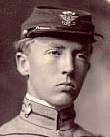
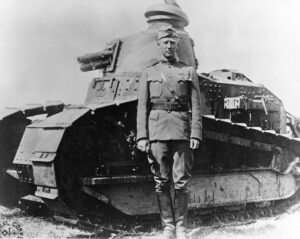 There are men of war, and then there are men of war. United States General George S Patton was the latter…meaning that he almost lived for war. Patton was a man who came from a long line of military people, and while he wasn’t always a tactful man, he was a great warrior…a fact that he proved over and over again. Many people didn’t like him much, but they couldn’t deny his capabilities. Patton was a great leader, but he wasn’t really a people person, and that got him in some trouble.
There are men of war, and then there are men of war. United States General George S Patton was the latter…meaning that he almost lived for war. Patton was a man who came from a long line of military people, and while he wasn’t always a tactful man, he was a great warrior…a fact that he proved over and over again. Many people didn’t like him much, but they couldn’t deny his capabilities. Patton was a great leader, but he wasn’t really a people person, and that got him in some trouble.
George Smith Patton Jr, who was born to George Smith Patton Sr and his wife, Ruth Wilson, the daughter of Benjamin Davis Wilson on November 11, 1885, in San Gabriel, California. Maybe because of his family history, or maybe it was just him, but Patton never seriously considered a career other than the military. At the age of seventeen he tried for an appointment to the United States Military Academy at West Point, New York. He also applied to several universities with Reserve Officer’s Training Corps programs, and was accepted to Princeton College, but eventually decided on Virginia Military Institute (VMI), which his father and grandfather had attended. Later, after studying at West Point, he served as a tank officer in World War I. Patton loved the tank, and his time as a tank officer, as well as his military strategy studies led him to become an advocate of the crucial importance of the tank in future warfare. When the United States entered World War II, Patton became the logical choice for the command of an important US tank division, and his division played a key role in the Allied invasion of French North Africa in 1942. Then, in 1943, in the Allied assault on Sicily, Patton and the US 7th Army in its assault on Sicily and won fame for out-commanding Montgomery during their pincer movement against Messina. Patton loved competition, and this was his chance to shine. On August 17, 1943, Patton and his 7th Army arrived in Messina several hours before British Field Marshal Bernard L Montgomery and his 8th Army, winning the unofficial “Race to Messina” and completing the Allied conquest of Sicily.
Although Patton was one of the most capable American commanders in World War II, he was also one of the most controversial. Patton was a “pull yourself up by your bootstraps” kind of guy, and therefore had no personal understanding of fear or fatigue. PTSD, battle fatigue, or shell shock were conditions he could not accept in anyone. In fact, they infuriated him so much that he actually slapped two soldiers who were suffering with the conditions. During the Sicilian campaign, Patton generated considerable controversy when he accused a hospitalized US soldier suffering from battle fatigue of cowardice and then personally struck him across the face. The famously profane general was forced to issue a public apology and was reprimanded by General Dwight Eisenhower. They would have liked to “walk away” from Patton, but when it came time for the invasion of Western Europe, Eisenhower couldn’t find a general as formidable as Patton, so, once again Patton was granted an important military post. In 1944, Patton commanded the US 3rd Army in the invasion of France. Then, in 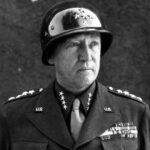
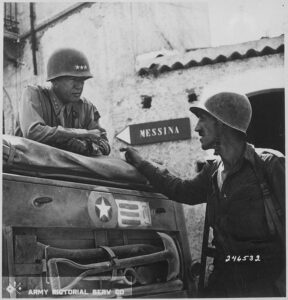 December of that year Patton’s great expertise in military movement and tank warfare helped to crush the German counteroffensive in the Ardennes.
December of that year Patton’s great expertise in military movement and tank warfare helped to crush the German counteroffensive in the Ardennes.
During one of his many successful campaigns, General Patton was said to have declared, “Compared to war, all other forms of human endeavor shrink to insignificance.” Patton died in a hospital in Germany on December 21, 1945, from injuries sustained in an automobile accident near Mannheim. He was just 60 years old.
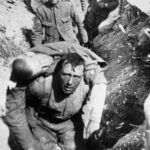 War is an ugly business, and the men and women who fight in wars are subjected to great stress and anxiety. These days, most of us recognize the term, PTSD (Post Traumatic Stress Disorder). We also recognize that a person doesn’t have to be in a war situation to have PTSD. Any traumatic event can trigger PTSD, and the symptoms of this disorder can be devastating. In fact, PTSD can result in things like suicide, attacks on others, institutionalization, or isolation.
War is an ugly business, and the men and women who fight in wars are subjected to great stress and anxiety. These days, most of us recognize the term, PTSD (Post Traumatic Stress Disorder). We also recognize that a person doesn’t have to be in a war situation to have PTSD. Any traumatic event can trigger PTSD, and the symptoms of this disorder can be devastating. In fact, PTSD can result in things like suicide, attacks on others, institutionalization, or isolation.
During World War II, PTSD (then known as Shell Shock) first came to the attention of the military leaders. On October 4, 1944, General Dwight D Eisenhower distributed to his combat units a report by the US Surgeon General that revealed the hazards of prolonged exposure to combat. The then General’s report read, “[T]he danger of being killed or maimed imposes a strain so great that it causes men to break down. One look at the shrunken, apathetic faces of psychiatric patients…sobbing, trembling, referring shudderingly to ‘them shells’ and to buddies mutilated or dead, is enough to convince most observers of this fact.” General Eisenhower had been on the battlefield, and so, knew firsthand of the “attacks” on the minds and emotions of these poor soldiers.

After evaluation of many cases of “Shell Shock” in the hospital wards, the American commanders came to the conclusion that the average soldier could last about 200 days in combat before suffering serious psychiatric damage. They looked into the fact that British commanders used a rotation method, pulling soldiers out of combat every 12 days for a four-day rest period, thereby enabling British soldiers to put in 400 days of combat before being deleteriously affected. The Surgeon General’s report went on to lament the fact that a “wound or injury is regarded, not as a misfortune, but a blessing.” Now, when a wound is considered a blessing, you know that things have taken a serious turn for the worst in the area of morale. That basically means that the soldiers will do just about anything to get off the battlefield. For them, death isn’t far from being acceptable either. General Eisenhower and the military leaders of that era could see that the war was clearly taking a toll on more than just men’s bodies. The far greater toll was on their minds and emotions.
 While I can see that the idea of a rotation, or a limited period of exposure to the battlefield could sound like a viable solution, in reality is is only a partial solution, and one that probably won’t really work. While the time spent on the battlefield can cause fatigue, both mentally and physically, it only takes one event to change the mental status of a person. Even a strong person is going to be effected by the horrific death of a comrade at the hands of a land mine. Yes, their own wounds would get them off the battlefield, but that will not take away the pictures of blood and death they have see on the battlefield. To take the soldiers off the battlefield after 200 days is a noble effort, but it is not likely to solve the problem of Shell Shock in the way that they had hoped. I guess that main thing is that they knew about it and were trying to fix it.
While I can see that the idea of a rotation, or a limited period of exposure to the battlefield could sound like a viable solution, in reality is is only a partial solution, and one that probably won’t really work. While the time spent on the battlefield can cause fatigue, both mentally and physically, it only takes one event to change the mental status of a person. Even a strong person is going to be effected by the horrific death of a comrade at the hands of a land mine. Yes, their own wounds would get them off the battlefield, but that will not take away the pictures of blood and death they have see on the battlefield. To take the soldiers off the battlefield after 200 days is a noble effort, but it is not likely to solve the problem of Shell Shock in the way that they had hoped. I guess that main thing is that they knew about it and were trying to fix it.

